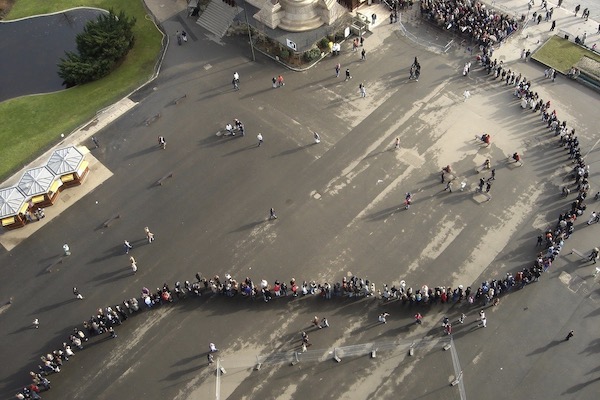Published on the 12/06/2025 | Written by Heather Wright

Foodstuffs NI trial opens floodgates…
Many of New Zealand’s leading retailers have announced their support for the use of facial recognition technology – likely indicating planned usage, or at least trialling, ahead for the stores – on the back of the success of Foodstuffs North Island’s trial and its tentative sign off by the NZ Privacy Commissioner.
Bosses of Briscoes, Bunnings, Mitre 10, Farmers, Foodstuffs South Island, Woolworths NZ and The Warehouse Group are among those to go public with their ‘strong’ support of the use of the technology to protect workers and customers.
“FRT is a powerful and effective tool alongside other crime prevention resources.”
Jeweller Michael Hill and telcos One NZ and Spark New Zealand also announced their support in the joint statement.
Their public showing follows last week’s report from the New Zealand Privacy Commissioner saying facial recognition technology in supermarkets has potential safety benefits.
The report follows the Commissioner’s inquiry which ran alongside Foodstuffs North Island’s six month trial of live facial recognition technology across 25 stores, using Imagus software from Australian company Vix Vizion.
An independent evaluation of the Foodstuffs trial found the trial prevented more than 100 serious harm incidents, including assaults, with a 16 percent reduction in harm demonstrated. Nearly 226 million faces were scanned during the trial, with 1742 alerts issued of which 1208 were confirmed matches. Of the 193 shoplifting attempts after an FRT alert, 120 were stopped by store staff.
In nine instances during the trial people were approached by staff but misidentified. In two cases the shopper was asked to leave.
The Privacy Commissioner’s report says the use of FRT during the trial was effective at reducing harmful behaviour, especially in reducing serious violent incidents.
That’s something retail bosses are keen to embrace.
“Our teams face high rates of verbal and physical abuse from repeat offenders who pose a risk to our employees, customers and other visitors to our stores,” the group says. “They are often responsible for significant violence, stock loss or damage.”
They go on to say they’re firmly of the opinion that FRT, when used fairly and accurately, can be a valuable intervention.
“It is a powerful and effective tool alongside other crime prevention resources such as security guards, fog cannons, staff training, body cameras, panic alarms, CCTV and other technology solutions.”
The group say they will work with Retail NZ to develop best practice to ensure FRT is used ‘only to keep our people safe, and in line with our obligations under the Privacy Act’.
A survey of more than 1,000 Kiwis by Foodstuffs North Island last year found that 66 percent of adults accept the use of FRT in retail stores, even if it only reduces harm by a small amount. If the harm reduction is greater, support increases, with 89 percent saying they’d accept use of the technology if it achieved a 10 percent reduction in harm.
A survey earlier this year for the Office of the Privacy Commissioner (OPC) of nearly 1,500 Kiwis also found concern about FRT had declined on last year, though Māori consistently showed higher concern, particularly over potential bias (57 percent, vs 48 percent across everyone) and use in retail settings (49 percent vs 41 percent)
The OPC report into Foodstuffs North Islands FRT trial notes that sometimes FRT will ‘self-evidently be effective to meet a specific lawful purpose’, but it also warned that the report isn’t a green light for more general use of the technology with FRT continuing to raise ‘significant privacy concerns’.
Those concerns include unnecessary or unfair collection of information, misidentification, technical bias and the ability to be used for surveillance.
The privacy safeguards used in the trial – which included immediate deletion of any unmatched images (99.999 percent of the nearly 226 million images were deleted within one minute), no sharing of watchlist information between stores and a 92.5 percent match requirement for triggering alerts – provide ‘some useful lessons for other businesses which may be considering using FRT’, Privacy Commissioner Michael Webster says.
Other safeguards included the system being set only to identify people who had engaged in seriously harmful behaviour; staff not being allowed to add images of anyone under 18, or those deemed to be ‘vulnerable’; and match alerts being verified by two trained staff, keeping human decision making as a key part of the process. Images collected were not allowed to be used for training data purposes and systems were reviewed and improved throughout the trial when misidentifications or errors occurred.
“What we have learned from this trial will enable other businesses to ask themselves the right questions about whether FRT is necessary and appropriate for them, and will give them strong guidance about what they would need to do to set FRT up in a privacy-safe way.”
The OPC has released a factsheet covering its expectations across nine key areas:
- Careful thought before deploying FRT – including ensuring the problem is serious enough to justify use of the technology, ensuring it will make enough of a difference to justify the cost and time involved in implementing and maintaining the system and identifying privacy risks and mitigations;
- Setting up and maintaining a watchlist – including defining target groups and setting clear, justified and consistent parameters, ensuring image quality is good enough for accurate matching, and having a plan for how to check whether your watchlist is biased;
- Installing and maintain the wider FRT operating system – including due diligence on the software provider, and setting a match level at a high enough percentage to avoid most misidentifications but not provide a false sense of security;
- Information for customers and access/correction of information;
- Alerts – including keeping humans in the decision making loop;
- Decisions on whether and how to intervene’
- Security of FRT systems and information – including limiting access to the information and protections to prevent data being extracted and sent elsewhere or systems being hacked
- Managing complaints and access or correction requests – including considering how you will deal with customer requests to be removed from a watchlist; and
- Review and monitoring – including keeping good records, regular reviews, being prepared to change settings to make things work better and being prepared to remove FRT if it causes issues or you no longer need it.
The Privacy Commissioner’s report references potential for a ‘more centralised system’ including a centralised offender dataset or watchlist, saying such a system could improve the effectiveness of retail FRT use where repeat offenders from other locations aren’t on a store’s watchlist, and may help mitigate data breach risks, based on the assumption it would be easier to protect a centralised system that those held in individual businesses.
That’s something New Zealand Justice Minister Paul Goldsmith has reportedly thrown his support behind, saying he wants officials to consider a centralised system – which the OPC says it would want to work with retails and police on the design, oversight and governance of, should one be proposed.
The Ministerial Advisory Group on Retail Crime, set up last year, has among providing advice on possible legislative changes to enable the use of FRT as one of its key initial objectives.
Foodstuffs North Island CEO Chris Quin confirmed to iStart the company had deployed Vix Vizion technology for the trial.
The Australian company’s Imagus face recognition and video analytics software which claims to provide multi-factor identity verification, with images and data stored on the customer’s systems.
NEC also has facial recognition offerings, with Macy’s among its customers. Hikvision, which has found itself on the wrong end of publicity over their use by Chinese authorities, also provides FRT, while SAFR’s offerings have reportedly been used by 7-Eleven.
Bunnings is among the companies lining up in support of the technology here in New Zealand. In Australia the company had its hands slapped last year with the Australian Privacy Commissioner saying the company had interfered with the privacy of individuals through its use of FRT for security and loss prevention.
It had been running the technology in 62 stores from 2019 to 2021.
The OAIC determination was accompanied by guidance on assessing privacy risks around the technology.



























